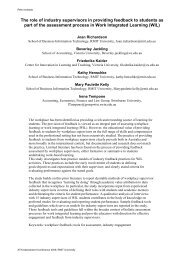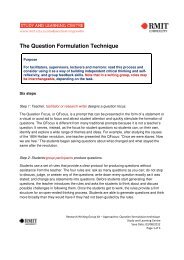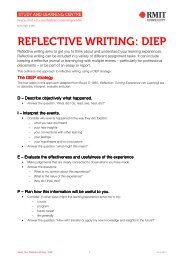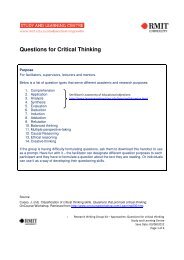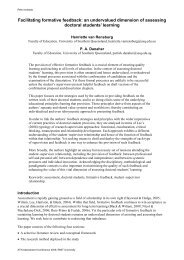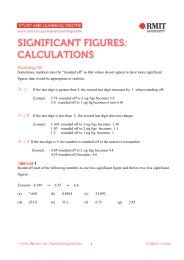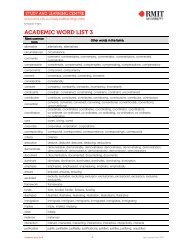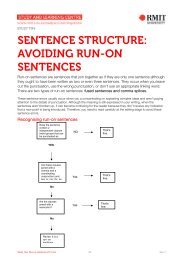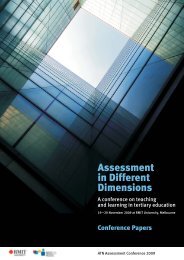student feedback and leadership - Office for Learning and Teaching
student feedback and leadership - Office for Learning and Teaching
student feedback and leadership - Office for Learning and Teaching
Create successful ePaper yourself
Turn your PDF publications into a flip-book with our unique Google optimized e-Paper software.
Part A: Developing a Distributed Leadership Model - Secton 3: Building Leadership Capacity<br />
3.3.3 Act<br />
This cycle commenced with a number of actions:<br />
1. The agreement by the Project Sponsor, DVC(A) to provide extra funding<br />
to support some of the initiatives <strong>for</strong> change that several of the ARTs<br />
had identified.<br />
2. The creation of a project website open to all staff in order to develop<br />
a more systematic approach to disseminating in<strong>for</strong>mation to assist<br />
transferability. Project documents including Reports, Notes from Plenary<br />
sessions <strong>and</strong> reference material being developed were placed on the<br />
website. Case studies of ART activities were publicised through the<br />
RMIT On-line <strong>Learning</strong> <strong>and</strong> <strong>Teaching</strong> magazine, Ed.<br />
3. A Mid Project Review was prepared <strong>and</strong> circulated <strong>for</strong> comment.<br />
This identified achievements over the first year of the project<br />
4. Interviews were held with a number of PVCs to complement the<br />
group <strong>feedback</strong> emerging from other project activities.<br />
5. ART members were invited to make presentations on what they were<br />
doing to improve <strong>student</strong> <strong>feedback</strong> to new Lecturers at Level A <strong>and</strong> B<br />
in the Graduate Certificate of Tertiary <strong>Teaching</strong> <strong>and</strong> <strong>Learning</strong>.<br />
The third Plenary was designed to enable ARTs to present their project<br />
progress on <strong>student</strong> <strong>feedback</strong> made during the first year. It was also designed<br />
to enable Heads of School to present their experience in building <strong>leadership</strong><br />
capacity resulting from the ART activities.<br />
ARTs stated that the project had led to an increase in discussion by staff<br />
in the School on how to improve teaching practice <strong>and</strong> learning outcomes<br />
<strong>for</strong> <strong>student</strong>s. This had resulted in a more positive approach to the CES<br />
than had been the case with staff spending less time on criticising the CES<br />
as an instrument <strong>and</strong> more time on what changes could be made to improve<br />
<strong>student</strong> <strong>feedback</strong>.<br />
Heads of School emphasised the importance of embedding the <strong>leadership</strong><br />
capacity that was being built by making changes within the School as well<br />
as disseminating the experience <strong>and</strong> outcomes across Schools <strong>and</strong> Colleges.<br />
Examples of action they had taken within the Schools included the introduction<br />
of incentives to extend teamwork to improving <strong>student</strong> <strong>feedback</strong> to other<br />
Program teams, the establishment of School-based <strong>Learning</strong> <strong>and</strong> <strong>Teaching</strong><br />
Committees, <strong>and</strong> the design of opportunities <strong>for</strong> staff to become leaders<br />
in learning <strong>and</strong> teaching within the School.<br />
Page 49



